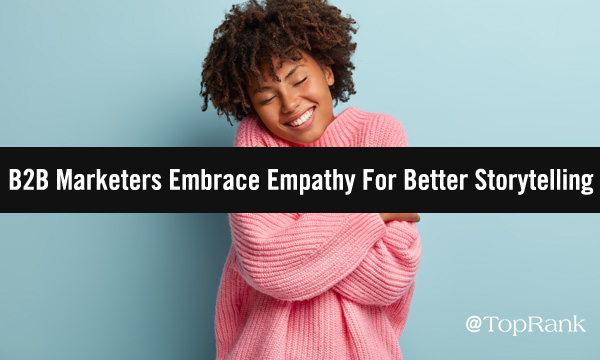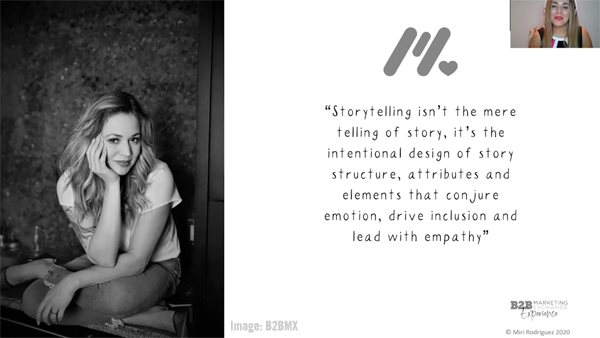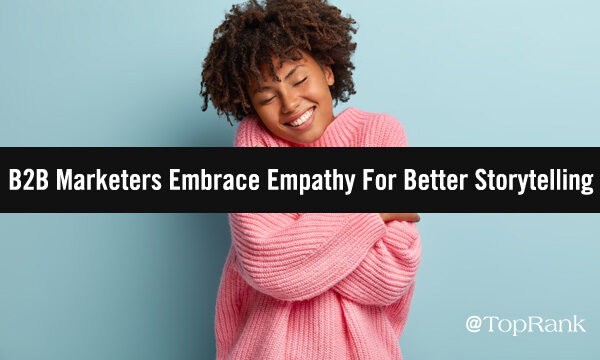
How do B2B marketers who fully embrace empathy build stronger relationships?
Miri Rodriguez, storyteller and internship program head at Microsoft, recently presented the opening keynote at the 2021 B2B Marketing Exchange Experience virtual conference, and asked this important question.
Although this pandemic year at #B2BMX won’t see B2B marketers gathered in the event’s usual sunny Scottsdale, Arizona location, plenty of new attendee opportunities were on tap virtually.
Refresh, renew, remix has been the conference’s theme this year, and to help ease the lack of physical networking #B2BMX included a Spotify music playlist, live music performances, and even various charitable elements.
Miri began by looking back at the history of empathy in B2B marketing, to when empathy was new to the B2B space, especially the practice of considering it a leading component of the digital experience.
Storytelling Uses Empathy to Move Past Numbers and Facts
Storytelling is not just the telling of stories, Miri explained, it’s also a design approach to stories that work on the human-to-human level of business marketing.
Telling stories in such compelling and connected ways that your messages are then also easily and willingly transmitted to your audience’s customers is a goal of B2B marketing that infuses genuine empathy, Miri said, and then began exploring empathy’s important role in brand storytelling.
Miri explained how in her role at Microsoft she began an examination of empathy by looking at what storytelling is not, asking industry brand professionals at many different levels for their insight.
Storytelling isn’t so much information, data, facts, or numbers, but the emotional transfer of that information using memorable characters, plots, and conclusions which all foster empathy, she noted.

The emotional transaction is the glue that binds customers to a brand’s message, making them feel connected at the most human level, Miri explained, and mentioned LinkedIn’s January 2020 report which found that empathy was the platform’s top 2019 theme — one that offers strength to both brands and customers.
“Brands want to transact with people who are showing high levels of empathy,” Miri noted.
“Brands want to transact with people who are showing high levels of empathy.” — Miri Rodriguez @MiriRod #B2BMX Share on XSince the pandemic began, empathy has only increased in its importance for B2B brands, and increasingly employees want to work for brands that include high levels of empathy, she noted.
How can you begin leading with empathy?
Miri mentioned the oft-used Bill Gates “content is king” adage as a jumping off point for all that exists beyond content for today’s B2B marketers seeking to infuse greater empathy in their brand storytelling efforts.
One key is finding a universal truth, especially when it’s an actionable emotion that your brand lives by, and Miri suggested that these types of truths often derive from a brand’s mission statement.
What Feeling Is Your Brand Story Sparking?
During her #B2BMX opening keynote Miri also put out the question, “What feeling is my brand story seeking to spark?”
Sometimes examining or even rethinking a brand’s mission can help B2B marketers find these key feelings, she suggested.
In her example from Microsoft, Miri shared how the firm came up with empowerment as its new mission several years back — a feeling that CEO Satya Nadella and the organization have embraced in many ways since.
Miri then asked, “Is your brand leading with a feeling that they can share with their customers?”
She urged B2B marketers to make brand stories easy to consume, which in turn will make them convenient for customers to pass on to their own associates and customers.
Miri also explored cognitive empathy, and the importance of seeing your customer first and foremost as a human. She urged B2B marketers to always keep in mind that there is a human on the other side of the screen, the other side of every email, in a physical room, or wherever you communicate with a customer.
It’s important for B2B marketers to allow themselves to recognize the type of emotional empathy that reaches out and makes connections on a more human level, and Miri shared how marketers can benefit when they retrain their brain to think about your humans instead of your customers.
Having conversations that go beyond the mere facts about a product or service and its features, to instead form deeper and more empathetic connections, will build the kind of trust that makes business transaction elements more meaningful, Miri observed.
She also looked at the type of compassionate empathy that can begin when B2B marketers take the time to assess themselves introspectively, examining personal vulnerabilities.
Empathize by being cognizant of the experiences your customers are going through, and recognize that especially those in the GenZ and millennial demographics frequently make connections that are more on the emotional side with the brands they do business with, Miri noted, and explained that these younger customers also aren’t necessarily buying a product merely for the product alone.
Often they are looking at a brand’s mission before deciding to do business with them, and some will even refuse to work with a brand that defaults to having no public mission or stance on social and other important issues, she said.
Seeing The Humans Behind The Brand
Miri spoke about the importance of allowing B2B customers to see the humans behind the brand, and urged marketers to pay attention to who they’re delivering a B2B brand’s story to, being mindful of the fact that an audience isn’t just your customer in B2B, but also the audiences of those customers.
Miri then asked several key questions:
- Why should your end-user care about your story?
- What insight does your content include?
- Does it educate and otherwise help your customers, beyond simply helping with a particular feature of a product or service?
For every B2B marketing story you set out to tell, Miri recommends first asking yourself who the story is dedicated to, how it can help them, and how it will hopefully make them feel, especially when the story is tied in to one of your brand’s universal truths.
Showing the origin of your brand’s story is important, Miri said, as is reminding your customer why your brand is important to them.
An ideation phase includes finding the solutions your customers want in the formats they prefer, and Miri shared an example from Microsoft in which customers pointed out that they preferred blog content written not so much by marketers but by people directly involved a particular area of expertise.
Low-cost and low-effort story prototyping can also be a great way to test a variety of creative concepts, Miri noted, before moving on to the testing and implementation stages.
Making Genuine Audience Connections That Evoke Emotion
Are your brand storytelling efforts evoking the type of emotion you want to foster with your content? Miri explained that reach and engagement are both helpful in determining which efforts are making genuine connections with your audience.
Miri concluded her insightful and energetic #B2BMX keynote presentation by reinforcing the notion that genuine B2B brand stories always contain a character, plot, story, and conclusion, and that powerful storytelling only happens in the B2B space when marketers tell their stories for their audiences, and not to them — ideally with empathy, creativity, authenticity, and heart.
Empathy in B2B marketing is a topic near and dear to our team at TopRank Marketing, and to learn more about bringing it to life in your own marketing efforts, contact us, and check out the following five recent resources we’ve published:



